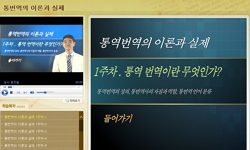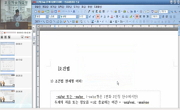조선을 건국한 주체 세력들은 자신들이 구상한 문명으로 조선을 끌고 가려는 노력을 아끼지 않았다. 그러나 문자의 소유를 통한 권력을 자신들이 독점하고 있는 이상, 이는 명확하게 한계를...
http://chineseinput.net/에서 pinyin(병음)방식으로 중국어를 변환할 수 있습니다.
변환된 중국어를 복사하여 사용하시면 됩니다.
- 中文 을 입력하시려면 zhongwen을 입력하시고 space를누르시면됩니다.
- 北京 을 입력하시려면 beijing을 입력하시고 space를 누르시면 됩니다.
https://www.riss.kr/link?id=A60073099
- 저자
- 발행기관
- 학술지명
- 권호사항
-
발행연도
2012
-
작성언어
Korean
- 주제어
-
등재정보
KCI등재
-
자료형태
학술저널
-
수록면
165-188(24쪽)
- 제공처
-
0
상세조회 -
0
다운로드
부가정보
국문 초록 (Abstract)
그러나 정부는 백성들을 교화하여 유교적 문명의 자장(磁場) 안으로 끌어들일 필요가 있었다. 그 일환으로 언해가 선택된다. 언해는 외국어(원천언어), 특히 한문 서적을 정음(목표언어)으로 번역하는 행위를 통칭한다. 과거에 향찰이 존재했었지만 그것은 한자의 음과 훈을 이용하는 것이었으므로 우리말을 온전히 표기할 수 없었다. 정음은 이러한 문제의 상당 부분을 해결해주는 문자였다.
언해는 기본적으로 소통을 위한 것이었다. 언해는 조선의 문명 수준을 한 단계 올리는 중요한 역할을 했다. 원천언어에 대한 분석과 목표언어로의 재구성은 서로 다른 문명으로의 전환을 시도하는 것이었고, 그 과정에서 원천언어에 대한 깊은 이해, 새로운 우리말 문체의 발견 등과 같은 학문적 성과가 나타났다. 그러나 원천언어를 하나의 모범으로 보고 그것을 통해 목표언어 사용자들을 교화하려는 목적을 가지고 있었으므로, 언해의 이면에는 문화적 폭력이 자리하고 있었다. 처음에는 그러한 것이 중화문명으로 조선을 편입시키기 위한 것이었지만, 시간이 흐를수록 백성들의 인식을 높임으로써 중화문명으로부터 벗어나는 계기가 되기도 했다. 언해를 통해 중세 지식이 습득되고 나아가 새로운 조선 문명의 건설로 나아가게 되는 계기에 대한 섬세한 연구가 필요하다.
조선을 건국한 주체 세력들은 자신들이 구상한 문명으로 조선을 끌고 가려는 노력을 아끼지 않았다. 그러나 문자의 소유를 통한 권력을 자신들이 독점하고 있는 이상, 이는 명확하게 한계를 가지는 것이었다. 훈민정음 창제를 둘러싸고 논쟁이 일어났던 것은 그러한 맥락에서 보아야 한다. 한자보다 훨씬 배우기도 쉽고 표기 범위도 넓은 정음은 백성들의 수준을 끌어올릴 수 있는 도구이면서 동시에 지식 권력을 비판하는 도구이기도 했다.
그러나 정부는 백성들을 교화하여 유교적 문명의 자장(磁場) 안으로 끌어들일 필요가 있었다. 그 일환으로 언해가 선택된다. 언해는 외국어(원천언어), 특히 한문 서적을 정음(목표언어)으로 번역하는 행위를 통칭한다. 과거에 향찰이 존재했었지만 그것은 한자의 음과 훈을 이용하는 것이었으므로 우리말을 온전히 표기할 수 없었다. 정음은 이러한 문제의 상당 부분을 해결해주는 문자였다.
언해는 기본적으로 소통을 위한 것이었다. 언해는 조선의 문명 수준을 한 단계 올리는 중요한 역할을 했다. 원천언어에 대한 분석과 목표언어로의 재구성은 서로 다른 문명으로의 전환을 시도하는 것이었고, 그 과정에서 원천언어에 대한 깊은 이해, 새로운 우리말 문체의 발견 등과 같은 학문적 성과가 나타났다. 그러나 원천언어를 하나의 모범으로 보고 그것을 통해 목표언어 사용자들을 교화하려는 목적을 가지고 있었으므로, 언해의 이면에는 문화적 폭력이 자리하고 있었다. 처음에는 그러한 것이 중화문명으로 조선을 편입시키기 위한 것이었지만, 시간이 흐를수록 백성들의 인식을 높임으로써 중화문명으로부터 벗어나는 계기가 되기도 했다. 언해를 통해 중세 지식이 습득되고 나아가 새로운 조선 문명의 건설로 나아가게 되는 계기에 대한 섬세한 연구가 필요하다.
다국어 초록 (Multilingual Abstract)
Government needed to edify the people and draw them into the spiritual territory of Confucian civilization. This is where eonhae, which could be directly translated as the vernacular translation, comes in. Eonhae refers to the translation of foreign language (source language), mostly Classical Chinese texts into Hunmin jeongum(target language). Hyangchal existed in the past, but this writing system which transcribed Korean by borrowing the meaning and sound of Chinese characters fell far short for the given mission. Hunminjeongeum was the script that solved a considerable portion of this problem.
Eonhae basically existed for communication. It also played an important role at elevating the level of Korean civilization. Analysis of the source language and reconstruction of the target language was an attempt to transform into a different civilization and, in doing so, deeper understanding of source language and discovering new styles of Korean writing followed. However, a cultural violence was underlying in eonhae from the outset, for its purpose was to educate the users of target language while the source language served as an exemplary model. Hence, at first, it worked toward incorporating Joseon into the Chinese civilization, but as people’s level of intellect and perception increased, it provided the opportunities to escape from the China-centric worldview. Thus, a meticulous research is required to understand how eonhae opened new avenues for acquiring the medieval knowledge and served as a momentum in establishing the new civilization of Joseon.
The main agents that founded Joseon endeavored to lead Joseon to the civilization that they initially conceived. However, as they monopolized the power by dominating the scripts, which was the Classical Chinese, this effort had a clear limitation. The...
The main agents that founded Joseon endeavored to lead Joseon to the civilization that they initially conceived. However, as they monopolized the power by dominating the scripts, which was the Classical Chinese, this effort had a clear limitation. The controversies that surrounded the invention of Hunminjeongeum, the Koreanalphabet, should beunderstood in this context. Hunminjeongeum, which was much easier to learn and write, was both the tool that could raise the intellectual level of ordinary lay men and the means to criticize the intellectual power.
Government needed to edify the people and draw them into the spiritual territory of Confucian civilization. This is where eonhae, which could be directly translated as the vernacular translation, comes in. Eonhae refers to the translation of foreign language (source language), mostly Classical Chinese texts into Hunmin jeongum(target language). Hyangchal existed in the past, but this writing system which transcribed Korean by borrowing the meaning and sound of Chinese characters fell far short for the given mission. Hunminjeongeum was the script that solved a considerable portion of this problem.
Eonhae basically existed for communication. It also played an important role at elevating the level of Korean civilization. Analysis of the source language and reconstruction of the target language was an attempt to transform into a different civilization and, in doing so, deeper understanding of source language and discovering new styles of Korean writing followed. However, a cultural violence was underlying in eonhae from the outset, for its purpose was to educate the users of target language while the source language served as an exemplary model. Hence, at first, it worked toward incorporating Joseon into the Chinese civilization, but as people’s level of intellect and perception increased, it provided the opportunities to escape from the China-centric worldview. Thus, a meticulous research is required to understand how eonhae opened new avenues for acquiring the medieval knowledge and served as a momentum in establishing the new civilization of Joseon.
목차 (Table of Contents)
- 국문초록
- 1. 훈민정음 창제라는 사건
- 2. 문화의 독자성과 보편성 : 조선 전기 지식인과 중화문명
- 3. 언해의 필요성과 그 의미
- 4. 중화문명으로의 편입과 탈출의 경계선에서
- 국문초록
- 1. 훈민정음 창제라는 사건
- 2. 문화의 독자성과 보편성 : 조선 전기 지식인과 중화문명
- 3. 언해의 필요성과 그 의미
- 4. 중화문명으로의 편입과 탈출의 경계선에서
- Abstract
- 참고문헌
동일학술지(권/호) 다른 논문
-
- 동악어문학회
- 배연형(Bae, Yeon Hyung)
- 2012
- KCI등재
-
- 동악어문학회
- 윤인숙(Yun, In Sook)
- 2012
- KCI등재
-
- 동악어문학회
- 홍선미(Hong, Sun Mi)
- 2012
- KCI등재
-
조선전기 두시(杜詩) 이해의 지평과 『두시언해(杜詩諺解)』 간행의 문학사적 의미
- 동악어문학회
- 김남이(Kim, Nam Yi)
- 2012
- KCI등재





 DBpia
DBpia






